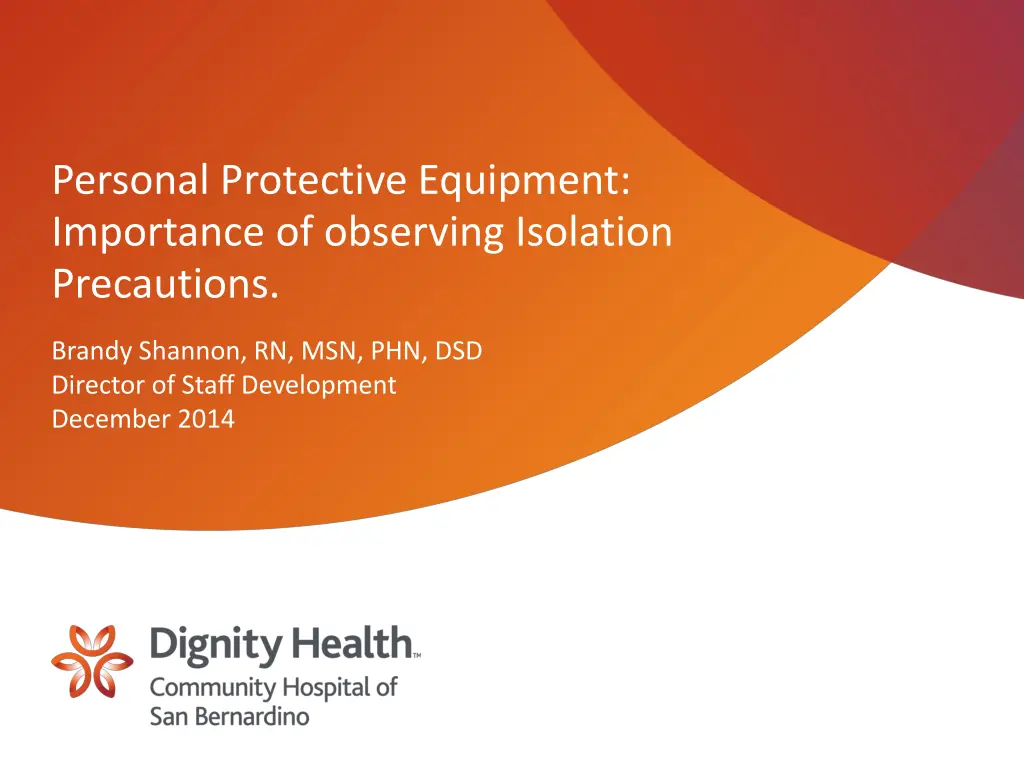
Importance of Observing Isolation Precautions in Healthcare Setting
Learn about the significance of personal protective equipment (PPE), standard precautions, and hand hygiene in healthcare settings. This presentation emphasizes the importance of observing isolation precautions and educating staff on proper PPE utilization to prevent the spread of diseases.
Download Presentation

Please find below an Image/Link to download the presentation.
The content on the website is provided AS IS for your information and personal use only. It may not be sold, licensed, or shared on other websites without obtaining consent from the author. If you encounter any issues during the download, it is possible that the publisher has removed the file from their server.
You are allowed to download the files provided on this website for personal or commercial use, subject to the condition that they are used lawfully. All files are the property of their respective owners.
The content on the website is provided AS IS for your information and personal use only. It may not be sold, licensed, or shared on other websites without obtaining consent from the author.
E N D
Presentation Transcript
Personal Protective Equipment: Importance of observing Isolation Precautions. Brandy Shannon, RN, MSN, PHN, DSD Director of Staff Development December 2014
Goal The goal of this presentation is to reinforce the importance of observing Isolation precaution, personal protective equipment (PPE) and standard precautions when working with patients. 2
Objectives At the completion of this presentation the healthcare staff will be able to: Verbalize how to be aware of which patients are on insolation precautions. Knowledge of proper PPE utilization. Knowledge of standard precautions. Have a better understanding of how to inform family and visitors on utilization of PPE. 3
Standard Precautions Standard precautions are a set of infection control practices used to prevent transmission of diseases that can be acquired by contact with blood, body fluids, non-intact skin (including rashes), and mucous membranes. These measures are to be used when providing care to all individuals, whether or not they appear infectious or symptomatic. 4
Hand Hygiene Hand hygiene refers to both washing with plain or anti-bacterial soap and water and to the use of alcohol gel to decontaminate hands. When hands are not visibly soiled, alcohol gel is the preferred method of hand hygiene when providing health care to clients. 5
Hand Hygiene Hand hygiene should be performed before and after contact with a client, immediately after touching blood, body fluids, non-intact skin, mucous membranes, or contaminated items (even when gloves are worn during contact), immediately after removing gloves, when moving from contaminated body sites to clean body sites during client care, after touching objects and medical equipment in the immediate client-care vicinity, before eating, after using the restroom, and after coughing or sneezing into a tissue as part of respiratory hygiene. Hand hygiene is the single most important method in reducing the spread of pathogens. -These are the CDC guidelines - 6
Personal Protective Equipment (PPE) The healthcare staff must use the appropriate PPE when caring for Resident. Personal protective equipment (PPE) is any type of face mask, glove, or clothing that acts as a barrier between infectious materials and the skin, mouth, nose, or eyes (mucous membranes). When used properly, personal protective equipment can help prevent the spread of infection from one person to another. 8
Choosing the appropriate PPE How to know who is on insolation precaution and which PPE to use? Observe the sign next to the Residents door, ask the charge nurse, and always communicate with other staff members during report and/or change of shift. 9
Isolation Precautions Observe the sign outside the Residents room and make sure you find out if its contact, droplet, or airborne precautions. 10
Contact Precautions Direct or indirect contact with skin or mucous membranes Indicated for: Multi-drug Resistant Organisms Clostridium difficile (C.dif.) RSV (Respiratory Syncytial Virus) Scabies ATTIRE WORN CONTACT ISOLATION ( In addition to STANDARD PRECAUTIONS ) GLOVES: REQUIRED. Remove gloves before leaving the room HANDS: Use antimicrobial soap and water or alcohol gel if hands are not visibly soiled. GOWNS: REQUIRED when there is a possibility of contact with patients, surfaces, or patient care items.
Droplet Precautions Mucous membrane to mucous membrane contact with an infectious agent Indicated for: MDRO in Sputum Meningitis Pertussis Influenza ATTIRE WORN DROPLET ISOLATION ( In addition to STANDARD PRECAUTIONS ) MASK: Mask covering eyes, nose AND mouthREQUIRED when you are within 3 feet of the patient. GLOVES: REQUIRED if you will touch anything contaminated with respiratory secretions. GOWN: REQUIRED if clothing will contact contaminated surfaces or respiratory secretions HANDS: USE ANTIMICROBIAL SOAP & WATER OR ALCOHOL GEL IF HANDS ARE NOT VISIBLY CONTAMINATED.
Airborne Precautions Infectious Airborne droplets or aerosols into lungs Indicated for: Tuberculosis Varicella Zoster (Chicken Pox) Measles (Rubeola) SARS (and Contact Precautions Avian Flu (and Contact Precautions) ATTIRE WORN AIRBORNE ISOLATION ( In addition to STANDARD PRECAUTIONS ) Keep room door(s) closed at all times. Dedicated room and HEPA Filter Unit REQUIRED MASK: N95 mask REQUIRED BY ALL EMPLOYEES at all times while in room. Patient must remain in the room unless absolutely necessary. During transport, place a surgical mask on the patient. HANDS: USE ANTIMICROBIAL SOAP & WATER OR ALCOHOL GEL IF HANDS NOT VISIBLY CONTAMINATED.
Isolation Precautions All healthcare staff and visitors must observe the correct isolation precautions and utilizing proper PPE. It is imperative that healthcare staff lead by example and utilize the correct PPE when entering the Resident s room. 14
Utilizing PPE Inform the visitor of the isolation precautions and where to find the proper PPE. Using good communication skills explain the importance of utilizing the appropriate PPE and observing standard precautions-hand washing. 15
Thank You: Please take the quiz.
